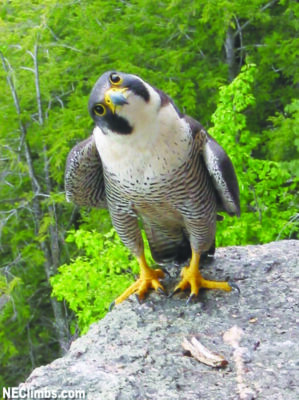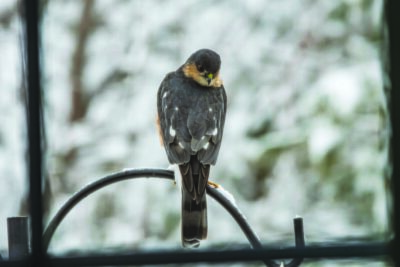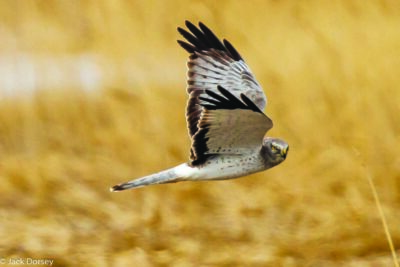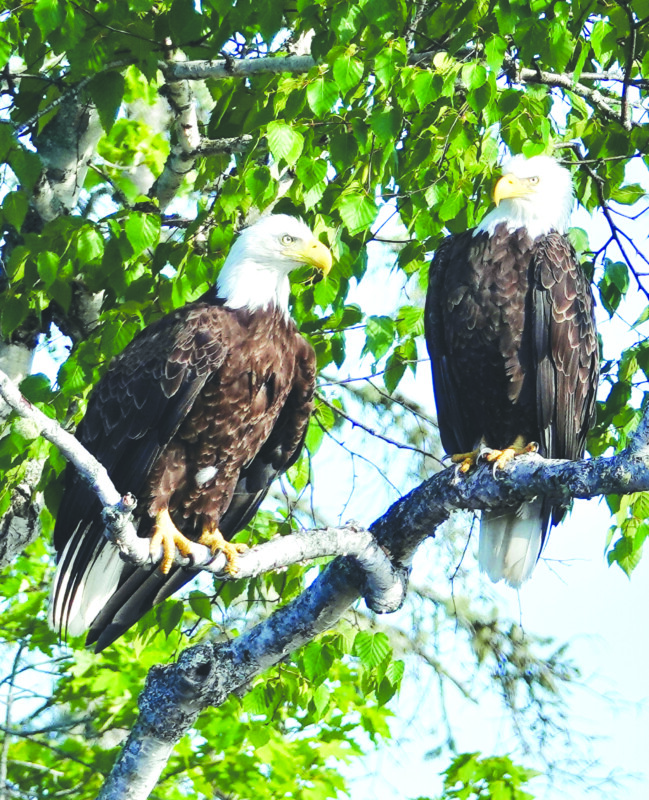With fall around the corner, we will soon see the days get shorter, the temperatures cooler, and many hawks in the sky. According to Chris Martin, wildlife and conservation biologist at the New Hampshire Audubon, September through November is the time frame in which hawks migrate to their wintering locations, making fall an ideal time for hawk watching.
Not all hawks migrate. What classifies these species of birds as what we call birds of prey is their feet, which actually makes “raptor” the more accurate term.
“Some people refer to them as birds of prey … but that is sort of an artificial category,” Martin said. “The fact is almost all birds are carnivorous [to] some degree. … What separates these birds of prey is the fact that they have feet that are adapted to grasp living food items. … ‘Raptorial’ refers to that sort of style of foot that includes long claws and strong grasping feet.”
In New Hampshire, seven common categories of raptors are owls, accipiters, buteos, eagles, falcons, harriers and ospreys. Each is broken down further into different species as the result of evolution and natural selection, Martin says.
“The differences are based on their evolution and how they specialize,” he said. “Each group specializes in how they hunt, where they hunt, what they hunt for, and then they have specialties in the kind of habitat they put their nests in. The idea is [they] don’t want to compete with other types of birds of prey if [they] can create a specialty that works for [them].”
Common NH raptor species
Osprey
According to Martin, the driving factor for raptors to migrate is the availability of food.
Ospreys are the perfect example of how important this can be, as they rely almost exclusively on fish. With lakes being covered in ice here in New Hampshire during the winter, ospreys migrate to South America and the tropics in the fall. In the spring they return, except for the young ospreys, who, interestingly, don’t return until the following spring when they are 2 years old. While it is not clear why ospreys do this, Martin says it could be to hone their fish-catching skills.

“It’s certainly an odd strategy, but it seems to work,” Martin said.
The fishing strategy that ospreys use is unlike that of any other raptor, according to Martin.
“They evolved this style of diving into water and catching fish,” he said. “Other birds of prey use [their] feet to fish [but] in a different way than this. Osprey will fly over still water, like a lake, and see a fish near the surface and drop in on it from 50 feet above it. They go in feet first and grasp it as they hit the water, oftentimes [disappearing] into the water before [rising] back to the surface and [flying] off with a fish.”
According to hawkwatch.org, ospreys’ feet are specialized for grasping, with all four of their talons curved more than that of other raptors. They also have spicules, or small spines, on the bottom of their feet and the ability to rotate their outer toe backward to hold slippery objects and carry fish. They have black feathers on their topside, a white head with a black eye-line, and when in flight, they glide on bowed wings that form an “M” shape.
Returning to the north in the spring can be a gamble for osprey.
“[They] push the limits when they come back at the end of March,” Martin said. “Oftentimes the water around their nest site where they spend the spring and summer is still frozen when they get back [and] they have to resort to nearby flowing water and rivers. … That can be a challenge because it can be cloudy or muddy in the spring and they can’t see the fish that they’re trying to hunt.”
Many raptors are in a hurry to return and reclaim their breeding sites before they are taken over by another bird. Ospreys sometimes use dead trees that are exposed in marshes, a niche that most other birds of prey don’t occupy. They can also be found using transmission lines, telephone poles and electrical poles. In fact, Martin adds, it’s possible a quarter of our osprey population uses cell towers for their nests.
“They’re pretty adaptable to all sorts of environments,” he said.
Barred owl
At night, while other raptors are resting at their roosts, owls are active and on the hunt for voles, shrews, mice and other prey. These nocturnal birds have a series of adaptations that make them deft for nighttime hunting. According to Martin, in addition to their ability to see well in the dark, they rely on their hearing and are able to detect prey rustling and moving through blades of grass.
“Their ears are not uniformly placed on either side [of their head],” he said. “One is higher and the other is lower on the side of the skull and that helps them differentiate where a sound is coming from. I think a barred owl could probably locate prey and go after it … even if it was blind.”
The shape of their face also enables them to effectively locate sound.
“‘Facial disk’ is the term that we use for it,” Martin said. “[They have a] flattened face that puts their eyes forward and the face actually focuses sound and delivers it to the ears, so it helps with the process of pinpointing where a rustling sound is coming from.”
Of all the owls we have in New Hampshire, like the barn owl, which doesn’t currently breed in the state, and the snowy owl, which only resides here in the winter, barred owls are the most common.
“Barred owls are medium-sized forest owls that are very vocal and have a call that is easily recognized [that] sounds like ‘who cooks for you?’” Martin said. “It’s one that you often might find in a forested backyard or park and they often vocalize during the day as well. They are the owls in the state that you’re most likely to encounter just in your everyday activities.”
Although they don’t live in wetlands — they nest in cavities in large trees in forests — barred owls are often associated with wetlands, as much of what they eat is located on the forested edge and in grass along the edge of a marsh, like salamanders and leopard frogs. They also hunt on roadside edges, particularly in areas where there are ditches that can collect water, as much of their prey is associated with water. This, however, poses a great risk.
“A lot of times they’re so focused on hunting that when they make a dive at sort of a 45-degree angle from their perch to the ground to grab [their prey], if that dive includes going over a roadside, they often get hit by vehicles,” Martin said. “One of our key wildlife rehabilitators in Henniker … at Wings of Dawn receives many injured barred owls that [are] injured on one side of their head because of impact with a vehicle. That’s a very common injury.”
Peregrine falcon
Among the fastest of all raptors are falcons. With their speed and long, pointed wings, they have adapted to dive and chase their prey down in midair. Three well-known falcons in New Hampshire are kestrels, merlins and, perhaps the most famous, the peregrine falcon. Although their plumage varies, adult peregrines tend to be white below and bluish gray above while juveniles start out with a buff color on their underside and brown to a slate-like color above, according to hawkwatch.org.

“That’s the one that’s been subject to a lot of restoration efforts nationwide in the 1980s through early 2000s, and we’ve pretty much recovered them from a point where they were almost extinct in the U.S.,” Martin said. “They’re still on our New Hampshire state threatened list, but their population has been growing gradually.”
Peregrines take advantage of vertical landscape features for their nests, whether natural like cliffs, or manmade structures such as buildings and bridges. From their perch they have an optimal view to look for prey, which consists mostly of other birds such as starlings, blue jays, robins and other medium-sized birds, or birds as big as pigeons, mourning doves and occasionally a small duck, according to Martin. While birds of prey will take what’s abundant in their environment, he says the size of the prey is a factor.
“There’s a limit to the size of the food item that they can bring back,” he said. “[A] pigeon is probably the biggest, bulkiest thing that they will eat regularly, and that’s a real challenge for a male peregrine because they are the smaller of the two sexes and they do most of the hunting. A pigeon is a big item for them. It probably weighs close to the same amount as a male peregrine.”
In addition to other birds, young peregrines will train for hunting by catching dragonflies and bats.
Something that helps peregrine falcons hunt is their ability to sense weakness or vulnerability in other birds, Martin says. For example, if a bird is fatigued from migrating and struggling to find a place to land, peregrines can pick up on that and home in on that bird as a target.
“[It’s] just remarkable that they can recognize something that is out of its element and utilize that as a food source,” Martin said.
Broad-winged hawk
If you’ve seen a hawk soaring in circles in the open over a field, or dropping down onto a highway median, it was likely a buteo. Their long, broad wings make wide open spaces suitable for these birds to hunt, as they are well-adapted to using thermal lifts to bring them up high where they can scan for food, according to Martin.
“They’ll fly in circles over a field or a forest and look for an item that’s vulnerable and then dive on that,” he said. “Or in some cases they’ll perch on phone poles or wires and drop down on a mammal they see in the grass.”
New Hampshire buteo species include red-shouldered hawks, broad-winged hawks and rough-legged hawks, the last of which are only here during the winter months. While the red-tailed hawk is most commonly seen, the broad-winged hawk is likely the most numerous, nesting in tree canopies in the forest and feeding on prey like squirrels and mice.
According to hawkwatch.org, broad-winged hawks are small buteos with a compact body, bulky chest, a large head and about a 35-inch wingspan.
“[Broad-winged hawks] are very abundant in the state as a breeder, and are famous in the fall for kettling, a whole bunch of them getting together in a group and … migrating south,” Martin said. “Thousands of broad-winged hawks will travel all the way down to the tropics and into northern South America in September mostly, and so hawk watches where you can see these birds kettling and migrating are actually very popular in the eastern U.S.”
Sharp-shinned hawk
While buteos have long wings that enable them to soar through the open sky, accipiters have short wings that allow them to navigate between trees and around obstacles to go after prey, which in most cases are other birds, according to Martin.

“You might encounter an accipiter when you’re hiking in the woods,” he said. “It might come right down the path at you because it’s flying through that gap in the forest. It’s not trying to attack you necessarily, but it’s using those narrow lanes to maneuver and oftentimes surprise its prey.”
The most common accipiter, and the smallest hawk in North America, according to hawkwatch.org, is the sharp-shinned hawk.
“They’re only slightly bigger than blue jays, so that’s a bird most people would recognize … although they’re a little tough to see because the forest canopy hides them much of the time,” Martin said.
In flight, these birds appear stocky with short, rounded wings and a long, slender tail, as reported by hawkwatch.org, which describes them as adeptly maneuverable and buoyant. From below, adults are barred white and rufous, with upper parts being a grayish blue with a blackish head. Their eyes start out yellow as juveniles, eventually turning orange, then dark red as they age.
Bald eagle
While famous for their bright white head, yellow beak, blackish-colored body and expansive wingspan — eagles are the largest of all raptors — bald eagles do not look this way until they are fully mature. As juveniles they appear brown overall with a dark bill and eyes and a black tail with some white mottling, according to hawkwatch.org.
The bald eagle population in New Hampshire has drastically increased in the last 30 years, according to Martin, thanks to efforts to give them better conditions.
“Near a river or a lake you have a really good chance of seeing a bald eagle,” he said. “[People] would not have said the same thing back in the 1960s, ’70s or ’80s, so that’s a really obvious change.”
The slope of the population continues to climb, doubling every six or seven years.
“I’m waiting for it to curve and flatten off,” Martin said. “I assume we’re going to reach a carrying capacity at some point soon, but the charts aren’t showing it yet.”
While not exclusively fish eaters, bald eagles are rather aquatic-focused and build their nests near large lakes and rivers. Rather opportunistic hunters, they’ll eat a variety of prey such as muskrats, herons, duck and turtles and will even scavenge on roadkill and carrion when turkey vultures aren’t around to do so in the winter.
“They’re very adapted to cold weather,” Martin said. “Once an eagle pair establishes a territory for breeding, almost all of them will be on that territory within 5 miles of the nest site year-round through the coldest part of our winter season. They’ll do nest maintenance … and defend their territory from rivals that might want to move in and take over the site.”
Northern harrier
The only type of harrier in North America, appropriately named the northern harrier, is among the rarest raptors in the state.
“In New Hampshire currently their populations are listed endangered,” Martin said. “We probably only have 10 to 20 pairs of them anywhere in the state.”
What sets these birds apart from other raptors is that while most nest on cliffs, trees or other elevated areas, harriers nest on the ground. The breeding population is concentrated up north in Coos County, where there tend to be more hayfields, swamps and shrubby areas.

“They go to great lengths to hide where they nest by landing away from the nest and walking through the grass and shrubs to get to it, as opposed to landing right on the nest, which can pinpoint where it is to anything that might be watching,” Martin said.
They build their nests in high, dry spots of wetlands in areas with shrubs and vegetation. This serves as a platform for their nest and keeps their eggs out of the water. This also means that they are surrounded by water on all sides like a moat, which adds another layer of protection. Like owls, harriers rely a great deal on their hearing, and they even have the facial disk that is characteristic of owls. Adult male harriers have a white underside and gray upper side with black wingtips and yellow eyes, according to hawkwatch.org. Below, adult females are a buff color with streaks of brown and dark brown above. Their eyes start out a dark brown but change to yellow over about three years. Juvenile harriers resemble adult females but have distinct rufous underparts.
In the wetlands they feed on frogs and small wetland birds, but they also travel upland to grassy areas and hayfields where they will follow farmers who are tending to their fields to find other prey.
Martin says, “Harriers will follow these mowers because … they’re oftentimes displacing mice and voles that nest in the grass … [and] creating grasshopper and white footed moth mortality. That makes those things just available … for the picking, for the harriers to grab and then take back to their young.”
Migration and hawk watching
With September through October being migration season for raptors, the fall (and the spring, when they return) is the perfect time for hawk watching.
Phil Brown, bird conservation director and land specialist for the Harris Center for Conservation Education, says the ideal places to spot hawks are along ridge lines with a clear opening to the north, and coastlines, as some species, like ospreys and eagles, will follow the Merrimack and Connecticut rivers, hunting fish along the way.
According to Brown, broad-winged hawks make up the majority of the birds counted during the Pack Monadnock Raptor Observatory hawk watch at Miller State Park in Peterborough.
“We count about 15 different species of raptors that migrate throughout the fall,” Brown said. “We see hawks that [nest] in New Hampshire and surrounding New England, also species that are coming from farther north that are passing through. … The very common species, the broad-winged hawk … makes up about 75 percent of our annual count.”
The Harris Center is a regional land trust and environmental education organization in Hancock. One of its main missions is land protection, and in its 50-plus years it has helped protect 26,000 acres of land. The Center also focuses on the conservation of species in need and educates the public on these topics. The Harris Center has taken sole responsibility for the Pack Monadnock Raptor Observatory, which was founded by NH Audubon in 2005. Every day from Sept. 1 through Nov. 20, staff or volunteers count and document raptors during fall migration while also engaging with the public.
“It’s a perfect combination of education and research,” Brown said. “It’s a great way to engage with thousands of visitors every year. I think last year we had over 6,000 visitors, which was about average.”
Second to the broad-winged hawk is the sharp-shinned hawk, with smaller numbers of other raptors like bald eagles, osprey, peregrine falcons and red-tailed hawks.
“Sometimes … we have really excellent days where there are 4,000 to 5,000 hawks seen in one day from the observatory from one point, so that tends to really be something that surprises folks,” Brown said.
As far as what kind of bird you will see on a given day, this varies depending on the point in the season, as they don’t all migrate at the same time. They each respond to different triggers in the environment, whether that be availability of their food source, change in daylight length, thermal formations or the presence of ice or snow, according to Brown.
“As a result, you never know what you’re going to see at the hawk watch from day to day,” he said. “We have a good idea of who’s coming next and generally what numbers, but we get surprised up there every day to some degree.”
According to the observatory, some birds, like the red-shouldered hawk, pass through at a fairly steady rate throughout most of the migration season. The data for broad-winged hawks, however, is heavily skewed.
“[Broad-winged hawks] all fly together within a two-week period typically,” Brown said. “It’s thought to be more of a social gathering of convenience. They all have to get to where they’re going in the same conditions, so they travel on particular weather days that are advantageous to their migration, and that tends to bring them together in the same places at the same time.”
Transmitters affixed to some of these birds have located raptors traveling as far as South America, with broad-winged hawks being located in Brazil, Bolivia and Colombia, according to Brown. He adds that others, like the bald eagle and peregrine falcon, have less of a journey, traveling a short way south of the state border.
Population and conservation
According to Brown, hawk populations are still in their recovery phase.
When populations were dangerously low in the 1960s, with some breeding species completely gone from the state, efforts were taken across the nation to recover them, Martin said.
“The two species that we’ve focused on the most in the last couple decades have been the bald eagles and the peregrine falcons, and both have seen great recovery,” said Sandi Houghton, wildlife diversity biologist with the New Hampshire Fish and Game Department.
According to Martin, in the 1960s all breeding peregrines and bald eagles in New Hampshire were gone. The culprit was DDT, an insecticide heavily used in the ’50s and ’60s that worked its way up the food chain to top-level predators like raptors, preventing them from breeding successfully. The chemical caused the shells of their eggs to be brittle and thin, which caused them to break during incubation and hindered the shells’ ability to preserve moisture and regulate gas exchange from inside and outside the egg.
“The problem was the adults didn’t die from it, so for years both eagles and peregrines were trying to breed and failing, but for all intents and purposes you’d look at them and you’d see healthy birds,” Martin said. “So the problem snuck up on us when all of a sudden those older adults started to die [and] there were no young birds to replace them. The population just plummeted.”
NH Audubon has worked with other organizations like New Hampshire Fish and Game, The Peregrine Fund and White Mountain National Forest Fund to restore the peregrine falcon population since the early 1980s. This included steps involving the land, the health of the birds and the behavior of people.
“For peregrines, the biggest problem at the beginning was they were all gone,” Martin said. “So there was an effort to return them to the state by releasing young ones that had been raised in captivity [through] a process called hacking.”
He said that two release sites were established in northern New Hampshire, as well as others in surrounding states. Audubon, along with New Hampshire Fish and Game, started asking and training volunteers to look and listen for the presence of peregrines, as well as checking cliffs for nests. In the ’80s, occupied cliffs began being documented. Signs would eventually be put up asking people to not climb in these areas. The Peregrine Fund also collected unhatched eggs to check for high levels of chemicals and the thickness of the shells. Rock climbers were enlisted to put identification bands on peregrine chicks for the purpose of documenting where they would eventually go and where they would nest.
NH Audubon provides a livestream video of a peregrine falcon nest at the Brady Sullivan Tower on Elm Street in Manchester. Martin says an adult pair lives there year-round and fledged four young this past June, marking the 23rd consecutive year the peregrines on Elm Street have produced offspring.
While peregrines are still listed as threatened in New Hampshire, according to Houghton, there have been promising signs of recovery.
“We’ve gone from seven pairs in 1990 to almost 30 pairs currently,” Martin said. “That’s been 30 years, so the population has been growing very gradually.”
Martin says similar efforts were taken to recover the bald eagle population, which has gone from zero documented pairs in the ’60s to 10 sites nests around 2000 and now 100 territorial pairs in the state.
“In 2017 we were able to delist them from our threatened and endangered species list due to their recovery, and since then we’ve continued to see exponential growth,” Houghton said. “They’re in many ways a conservation success story that serves as a model for other species.”
Hawk watches
Visit hawkcount.org for information.
- Alton Bay Hawk Watch
Alton
Fall: Sept. 10 to Oct. 15 - Carter Hill Observatory
Concord
Fall: Sept. 1 to Nov. 15 - Grant’s Hill
Gilmanton - Little Blue Job Mountain
Strafford, Farmington - Pack Monadnock Raptor Migration Observatory
Peterborough
Fall: Sept. 1 to Nov. 20 - Pitcher Mountain
Stoddard
Spring: March 1 to June 1
Fall: Aug. 20 to Nov. 30 - Peter Wood Hill
Deering
Spring: March 15 to April 30
Fall: Sept. 1 to Oct. 30
Featured photo: Bald eagle. Photo by Joe Grande.





